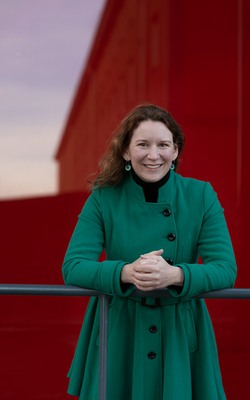Elin Bohman has been an ophthalmologist for a decade and has specialised in oculoplastic surgery and surgery of the eye socket.
Oculoplastic surgery and surgery of the eye socket comprises everything from widening the eye socket in patients suffering from exophthalamos to recreating eyelids after tumours and accidents.
"I have always known that I was going to do surgery. The fact that I focused on the eyes is because the vision means so incredible much to us humans. It feels significant to help patients with their eye problems," says Elin Bohman, Oculoplastic Surgeon and Director at St. Erik Eye Hospital and researcher at the Department of Clinical Neuroscience, Karolinska Institutet.
Elin Bohman spent her initial period as a researcher on eye prosthetics. She has, among other things, researched how to help people with chronic pain in the eye socket after the eye has been surgically removed.
"Here we have observed that using fatty tissue instead of the inserted implant in the eye socket after surgically removing the eye might help," says Elin Bohman.
As a researcher she describes herself as structured and organised.
"Since I must juggle several research projects with managerial tasks, while being a single mother and commuting 60 km to work I must be organised. There is no other way to make it all work out," says Elin Bohman.
Neglected patient group
In recent years she has devoted time to a patient group that she feels is misunderstood and neglected – people with teary eyes caused by blocked tear ducts.
"For some people it is so bad that they cannot work because tears fall onto the keyboard. Although not everybody experiences this, it can be experienced as socially stressful since teary eyes are a strong non-verbal signal. It also makes it more difficult to see," says Elin Bohman and compares the vision to looking out of a rainy window.
Elin believes that part of the reason the healthcare system is not taking the problem seriously, is that it has not been known how much the vision is actually affected. Since eye checks are carried out inside and the examined people are allowed to dry their eyes, they often lead to normal results.
However, thanks to Elin Bohman's research, it has now been evaluated that people with teary eyes experience as much trouble from visual impairment and from obstacles in their daily lives as people with cataracts in one eye.
"With this in mind it should be as obvious to operate on a blocked tear duct as on cataracts. The fact that the diagnosis is seven times more common in women may also have contributed to the lack of interest," she says.
The surgery method is important

Elin Bohman.
Photo: Johanna Hanno
You must look very far down the national prioritised list of which eye diseases to treat, before you find teary eyes. There it also says that surgery does not lead to good results. Here she has also provided new insights.
"The fact that all causes of teary eyes have been included, leads to the conclusion that surgery is not effective. For people with blocked tear ducts the results are very good with the right surgery method," says Elin Bohman.
In 2019 she published two studies where she mapped out how blocked tear ducts are treated in Sweden and in the other Nordic countries, including the long-term results of the procedure.
They revealed that the standard surgery method is a simpler operation, where the surgeon inserts a metal tube past the blockage to widen the tear duct. Subsequently a silicone tube is inserted that will stay in the tear duct until it has healed properly. In as many as 39 per cent of the patients the blockage reoccurred, and they needed repeat surgery after around six years.
If the blockage was underneath the lacrimal sac or if there were more blockages, almost 50 per cent experienced a reoccurrence and had undergone repeat surgery after six years.
"You could say that my research has shown that the simpler surgery method with a silicone tube will work if the blockage is positioned higher up, before the lacrimal sac. But if the blockage is further down a new duct should be drilled through the nasal bone and thereby making a bypass from the tear duct to the nose."
Currently around 150 such bypass operations are carried out a year by Elin Bohman and her oculoplastic surgeon colleagues at St. Erik Eye Hospital.
She believes that the results on how poorly the silicone tubes work for patients with blockages deep down are her most important contributions to research to date.
"I hope that this will make us better at choosing the correct surgery method here in Sweden, depending on where the blocked tear duct is positioned. Then we can avoid inserting unnecessary tubes in patients we know will have no long term benefits," says Elin Bohman.
Function of the lacrimal pump
Another important function to make the tears run away is the pumping capacity of the lacrimal sac. In cooperation with the Ophthalmology Clinic at Skåne University Hospital, Elin Bohman investigated how the lacrimal sac moves when we blink, and in that way pumps tears down the tear duct.
"We observed that the lacrimal sac primarily moves parallel to the nasal bone and not perpendicular to it as previously assumed. This gives some support to the theory that the lacrimal sac is ‘twisted’ each time we blink, so the tears are pumped into the tear duct and on to the nose."
Her hopes are that the research results will make an impact on healthcare.
"I hope that we in the Nordic countries will perform more bypass surgery in people with a blockage below the lacrimal bag. This, of course, requires that those deciding on priorities within ophthalmologic healthcare realise that teary eyes are a major problem for many people. In addition, they need to ensure that more people are trained to perform surgery on tear ducts."
Text: Jenny Ryltenius